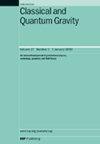BBN in constrained f ( T , ...
IF 3.7
3区 物理与天体物理
Q2 ASTRONOMY & ASTROPHYSICS
引用次数: 0
Abstract
In this article, we investigate the observational constraints for early Universe as well as the late-time accelerated expansion of the Universe in the realm of gravity, where is the torsion scalar and ϕ is a scalar field that modifies gravitational interactions. To analyze the early Universe, we utilize the big bang nucleosynthesis (BBN) constraints, while with cosmic chronometers (CCs), baryon acoustic oscillation (BAO) and Markov chain Monte Carlo (MCMC) analysis we addressed the-late time accelerated expansion constraints. Focusing on three specific models within the framework of gravity, we assess whether the freeze-out temperature predicted by each model meets the latest BBN observational bounds . To further evaluate the viability of these models in the late time Universe, we analyze the Hubble parameter H(z) across redshift z, utilizing CC and BAO datasets incorporating a confidence region to ensure alignment with empirical data. Additionally, MCMC analysis using CC data provides detailed constraints on parameters and quantifies uncertainties through contour plots. Results indicate that each model satisfactorily aligns with observational data from BBN, CC, and BAO measurements, positioning this framework as a promising alternative to the standard ΛCDM cosmology. We wrap up by conducting a thorough analysis of how each model, dataset, and prior combination interacts, offering insights into their collective impact on the cosmological parameter estimations and the overall model evaluation.约束条件下f (T,…)
在本文中,我们研究了早期宇宙的观测约束以及引力领域中宇宙的后期加速膨胀,其中φ是扭转标量,φ是修改引力相互作用的标量场。为了分析早期宇宙,我们利用了大爆炸核合成(BBN)约束,而通过宇宙计时器(CCs)、重子声学振荡(BAO)和马尔可夫链蒙特卡罗(MCMC)分析,我们解决了后期加速膨胀约束。以重力框架下的三个具体模式为重点,评估了每个模式预测的冻结温度是否符合最新的BBN观测界限。为了进一步评估这些模型在晚时间宇宙中的可行性,我们分析了哈勃参数H(z)跨越红移z,利用CC和BAO数据集合并置信区域以确保与经验数据一致。此外,使用CC数据的MCMC分析提供了对参数的详细约束,并通过等高线图量化了不确定性。结果表明,每个模型都与BBN, CC和BAO测量的观测数据令人满意地一致,将该框架定位为标准ΛCDM宇宙学的有希望的替代方案。最后,我们对每个模型、数据集和先前的组合如何相互作用进行了彻底的分析,并提供了它们对宇宙学参数估计和整体模型评估的集体影响的见解。
本文章由计算机程序翻译,如有差异,请以英文原文为准。
求助全文
约1分钟内获得全文
求助全文
来源期刊

Classical and Quantum Gravity
物理-天文与天体物理
CiteScore
7.00
自引率
8.60%
发文量
301
审稿时长
2-4 weeks
期刊介绍:
Classical and Quantum Gravity is an established journal for physicists, mathematicians and cosmologists in the fields of gravitation and the theory of spacetime. The journal is now the acknowledged world leader in classical relativity and all areas of quantum gravity.
 求助内容:
求助内容: 应助结果提醒方式:
应助结果提醒方式:


